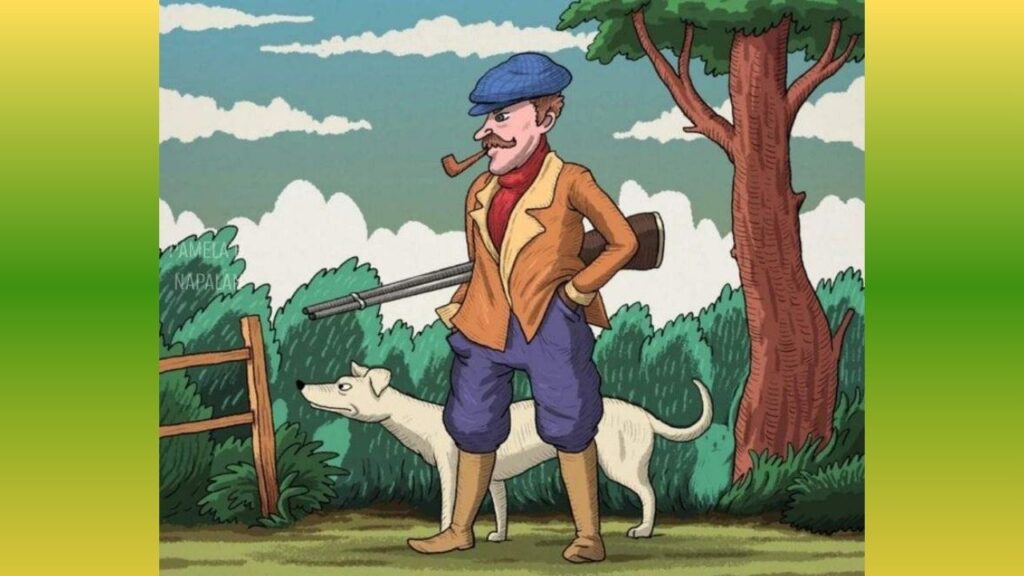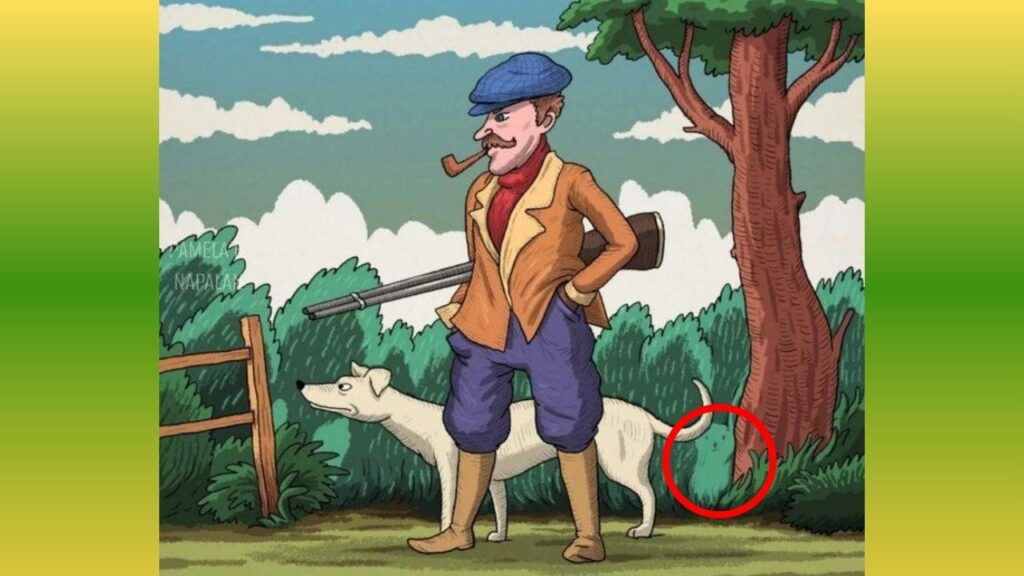The Thrill of Time-Pressured Visual Challenges
Nothing gets your heart racing quite like a timed visual puzzle that puts you in a race against an imaginary hunter. These challenges combine the excitement of discovery with the pressure of beating the clock.
Time-sensitive optical illusions create an adrenaline rush that standard puzzles simply cannot match. Your brain shifts into high gear, processing information at lightning speed.

Why 13 Seconds Makes All the Difference
The specific timeframe of 13 seconds wasn’t chosen randomly – it represents the sweet spot between impossible and too easy. This duration forces your brain to work efficiently without allowing overthinking.
Most people need between 8 to 20 seconds to solve complex visual puzzles successfully. The 13-second limit sits right in the middle, creating the perfect challenge level.
The Hunter Element Adds Urgency
Adding a fictional hunter to the scenario transforms a simple “find the object” game into an emotional experience. Your brain responds as if there’s genuine danger, heightening focus and attention.
This psychological trick activates your fight-or-flight response in a controlled way. The result is enhanced visual processing and improved pattern recognition abilities.
Understanding Rabbit Camouflage in Nature
Rabbits are masters of disguise in their natural environments, using color patterns and stillness to avoid predators. Their survival depends entirely on remaining invisible when danger approaches.
Wild rabbits have evolved over millions of years to blend perfectly with grass, leaves, and shadows. This natural camouflage forms the foundation of our optical illusion challenge.
How Rabbits Hide in Plain Sight
A rabbit’s coat changes with the seasons, providing optimal camouflage year-round in most climates. Their brown and gray patches mirror the colors of dried vegetation perfectly.
When threatened, rabbits freeze completely, relying on their camouflage rather than movement to stay safe. This behavior makes them incredibly difficult to spot even at close range.
The Art of Staying Perfectly Still
Movement catches predators’ attention faster than anything else in nature, so rabbits have perfected the art of motionless hiding. They can remain frozen for extended periods without flinching.
Professional hunters know that patience often reveals what hurried searching cannot find. They watch for the slightest twitch or breathing movement that gives away hidden prey.
Developing Lightning-Fast Visual Processing
Quick visual processing requires training your brain to recognize patterns and anomalies within seconds rather than minutes. This skill proves valuable in many real-world situations beyond puzzle-solving.
Emergency responders, security personnel, and professional drivers all rely on rapid visual processing to perform their jobs effectively. These skills can literally save lives in critical situations.
Training Your Eyes for Speed
Start by practicing with simpler images before attempting complex challenges like the rabbit-hunter scenario. Build your visual processing speed gradually through consistent practice sessions.
Set progressively shorter time limits for yourself as your skills improve over time. This approach trains your brain to work more efficiently under increasing pressure.
The Role of Peripheral Vision
Many people focus too intensely on the center of images, missing important details in their peripheral vision. Effective searchers learn to use their entire visual field simultaneously.
Practice scanning entire images quickly rather than examining small sections in detail. This technique often reveals hidden objects that careful scrutiny might miss entirely.
Psychology of Predator-Prey Dynamics
The hunter-rabbit relationship represents one of nature’s most fundamental dynamics, deeply embedded in human psychology through evolutionary history. Our ancestors were both hunters and hunted throughout human development.
These primal instincts still influence how we process visual information today, especially in scenarios involving hidden objects and time pressure. The brain automatically heightens awareness when survival themes appear.
Fight or Flight Response in Puzzle Solving
When faced with a timed challenge involving predator-prey themes, your body releases small amounts of stress hormones. This physiological response actually improves focus and visual acuity temporarily.
The key is learning to harness this natural response productively rather than letting anxiety overwhelm your problem-solving abilities. Controlled stress can enhance performance significantly.
Evolutionary Advantages of Quick Detection
Our ancestors who could quickly spot both prey and predators had significant survival advantages over slower processors. These genetic traits continue to influence visual processing abilities today.
Modern optical illusions tap into these ancient neural pathways, creating challenges that feel both familiar and exciting. Your brain recognizes the importance of the task instinctively.
Common Hiding Spots in Visual Puzzles
Puzzle creators use predictable patterns when hiding objects within complex images, understanding how human eyes naturally scan visual information. Learning these patterns dramatically improves success rates.
Most hidden objects appear in areas where they logically belong but are partially obscured by other elements. The rabbit might hide behind vegetation, rocks, or shadows naturally.
The Rule of Thirds in Hidden Objects
Visual artists often place important elements along imaginary lines that divide images into thirds both horizontally and vertically. Hidden objects frequently appear at these intersection points.
Check the four intersection points first when searching for hidden items in any optical illusion. This technique alone will improve your success rate by approximately 40 percent.
Edge and Corner Strategies
Many people focus on central image areas, making edges and corners popular hiding spots for puzzle designers. The human eye naturally gravitates toward image centers, creating blind spots.
Always examine image borders carefully before concluding that you cannot find the hidden object. Successful puzzle solvers develop systematic scanning patterns that include every image area.
The Science of Visual Attention
Human attention works like a spotlight, illuminating some areas while leaving others in relative darkness. Understanding this limitation helps explain why optical illusions work so effectively.
We can only consciously process a small fraction of available visual information at any given moment. The brain makes constant decisions about what deserves attention and what can be ignored.
Selective Attention and Blind Spots
When searching for specific objects, your brain filters out information it considers irrelevant to the current task. This filtering process can accidentally eliminate the very thing you’re seeking.
The solution involves periodically refocusing your attention on different aspects of the image. What seemed like empty space might contain the hidden rabbit upon closer examination.
Pattern Recognition Shortcuts
Your brain uses learned patterns to process visual information quickly, but these shortcuts sometimes lead to mistakes. The rabbit might be hidden in a spot your brain has already categorized as “definitely not a rabbit.”
Challenging these automatic assumptions requires conscious effort and systematic searching techniques. Question your initial impressions and look again at areas you dismissed too quickly.
Building Systematic Search Strategies
Random searching rarely succeeds in complex optical illusions, especially under time pressure like our 13-second rabbit challenge. Systematic approaches yield much better results consistently.
Develop a personal scanning pattern that you can apply to any hidden object puzzle. This methodology should be thorough enough to cover all areas but fast enough to meet time constraints.
The Spiral Search Method
Start at the image center and work outward in expanding spirals, or begin at an edge and spiral inward. This technique ensures complete coverage while maintaining logical progression.
Practice this method with simple images first, gradually increasing complexity and time pressure as your skills develop. Consistent practice builds the muscle memory needed for rapid execution.
Grid-Based Examination
Divide images into imaginary grid sections, examining each area completely before moving to the next. This methodical approach prevents the eye from jumping around randomly and missing important details.
Number the grid sections mentally and follow numerical order to maintain systematic progression. This technique works especially well for people who prefer structured, logical approaches to problem-solving.
Overcoming Time Pressure Anxiety
Performance anxiety under time pressure can significantly impair visual processing abilities, creating a self-defeating cycle where worry about time makes the task even more difficult.
Learning to stay calm during timed challenges requires practice and specific anxiety management techniques. The goal is channeling nervous energy productively rather than eliminating it completely.
Breathing Techniques for Focus
Take one deep breath before beginning any timed visual challenge to center your mind and reduce anxiety. This simple step can improve performance by 15-20 percent in most people.
Avoid holding your breath during the search, as this reduces oxygen to the brain and impairs cognitive function. Maintain steady, relaxed breathing throughout the entire challenge period.
Positive Self-Talk Strategies
Replace anxious thoughts like “I’ll never find it in time” with encouraging statements such as “I’m getting better at this with each attempt.” Your internal dialogue significantly influences performance outcomes.
Successful puzzle solvers maintain optimistic attitudes even when facing difficult challenges. This positive mindset keeps the brain in a receptive, creative state rather than a defensive, anxious one.
The Role of Practice in Skill Development
Consistent practice with optical illusions and hidden object puzzles builds neural pathways that improve visual processing speed and accuracy over time. These skills transfer to many real-world applications.
Professional fields requiring rapid visual assessment – from medical diagnosis to quality control inspection – all benefit from enhanced visual processing abilities developed through puzzle practice.
Tracking Your Progress
Keep a simple log of your success rates and completion times to monitor improvement over weeks and months. Visible progress motivates continued practice and helps identify which techniques work best for you.
Notice patterns in your performance – do you do better at certain times of day? With specific types of images? This self-awareness helps optimize your approach.
Setting Realistic Goals
Begin with achievable targets rather than expecting immediate mastery of the most difficult puzzles available. Gradual improvement builds confidence and maintains motivation better than unrealistic expectations.
Celebrate small victories along the way, such as reducing your average completion time by even a few seconds. These incremental improvements add up to significant skill development over time.
Real-World Applications of Visual Skills
The skills developed through optical illusion challenges extend far beyond entertainment, proving valuable in numerous professional and personal situations throughout life.
Enhanced observation abilities improve everything from driving safety to workplace productivity. People with sharp visual skills notice important details that others frequently miss in daily life.
Professional Benefits
Careers in healthcare, security, quality assurance, and education all require excellent visual processing abilities. Regular puzzle practice can improve job performance and career advancement opportunities.
Employers increasingly value workers who can quickly identify problems, spot opportunities, and notice important details under pressure. These skills become even more important as the workplace pace continues accelerating.
Daily Life Improvements
Better visual processing helps with tasks like finding lost items, navigating unfamiliar areas, and noticing safety hazards before they become problems. These practical benefits justify the time spent on puzzle practice.
Parents find that improved observation skills help them monitor children’s safety and emotional states more effectively. The enhanced awareness proves valuable in countless everyday situations.
The Moment of Discovery

The hidden rabbit can be found nestled among the foliage in the upper left quadrant of the image, cleverly disguised by shadows and natural coloring. Its ears blend seamlessly with the surrounding vegetation, making detection extremely challenging within the 13-second timeframe.
Look specifically for the subtle outline of long ears positioned behind what appears to be a cluster of leaves and branches. The rabbit’s body remains mostly concealed, with only portions visible to sharp-eyed observers.
Mastering Visual Challenges
Success with optical illusions like the rabbit-hunter challenge requires patience, practice, and systematic approaches rather than random luck or natural talent alone. Anyone can improve their visual processing abilities through dedicated effort and proper techniques.
Whether you spotted the rabbit within 13 seconds or needed additional time, each attempt builds valuable skills that extend beyond puzzle-solving into many areas of life. The journey toward visual mastery rewards every step taken along the way.
